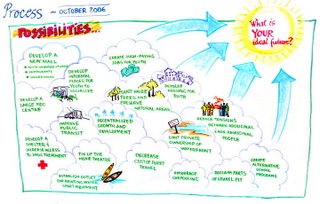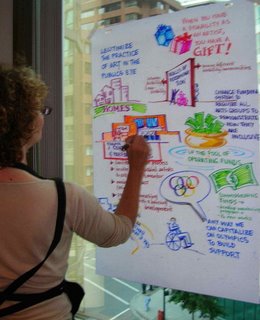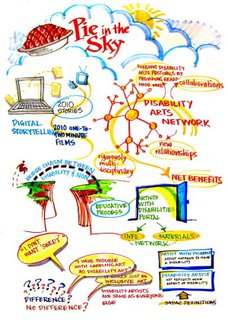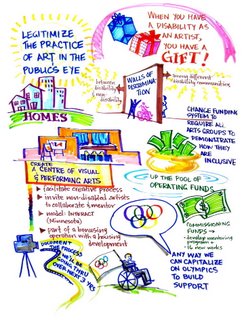skip to main |
skip to sidebar
A couple of entries ago I expressed a hope that I'd get permission to post the drawings from a session I did up in Whistler with the Imagine BC Sea-to-Sky group. Well, I got permission, so here are the drawings: (click on a picture to view a larger image)
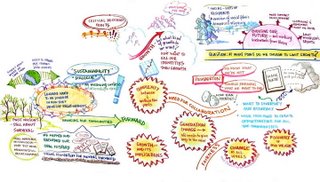

Confession: the top drawing is just a detail, not the whole sheet. When I looked at the original with a critical eye I realized it was kind of chaotic — the information from one area spilled over into another area so it was difficult to distinguish between the discrete parts. So I just posted the good bits here! The bottom drawing is better organized, I think — but then, I had the advantage of doing that one a bit after the fact, whereas the one above was done "live" as people were talking. That's the big challenge, trying to organize ideas and information that's flying at you thick and fast.
My mentor Christina Merkley subsequently coached me on how to organize information better on the page, with frames, heads and subheads, bullets, separator lines and so on. I tried to put those ideas into practice in my Sechelt drawings (Charrette Syndrome, below), and think I was fairly successful.
Another day, another lesson learned…
I'm so excited — I have just learned to lighten up!
"What are you talking about?" say those who know me. "You're one of the lightest people we know!" (As in light-hearted…and perhaps, at times, somewhat light-headed.) No, no, no. I'm not talking about me. I'm talking about my photos. Yes, folks, I just learned a terrific technique to lighten up the photos I take of my work, so that the background knocks out to white and the colours pop out brightly and clearly.
Not sure what I'm talking about? Well, a picture is worth a thousand words — so here's a picture to explain. Or rather, in this case, two pictures — the Before and After shot.
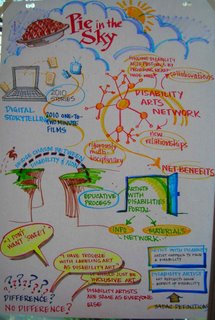
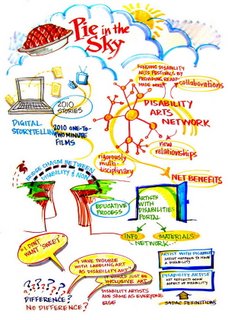
Quite a difference, no? The Before shot, on the left, is just how it came out of my camera. Which, because of imperfect lighting and the fact that the camera picks up all the gradations of light and shadow on the paper, comes out kind of grey. The After shot, on the right, is how it looks after I doctored it up with this nifty technique I learned a couple of days ago. Amazing, eh?
And it's not even difficult. A huge thank-you goes to Peter Durand of Alphachimp Studio in Pittsburgh. Peter edits the blog for the Center for Graphic Facilitation, which is a treasure trove of good information and ideas for people working in this field. Maybe he runs the Center too — or maybe the blog is the Center. I'm not too sure. Anyway, I registered as a GF on his site and asked him about cleaning up digital photos of drawings. I had learned about some software called Whiteboard, but it turns out not to be Mac-compatible (boo!!), so I wondered if there was some other way to do the job without having to shell out an awful lot of money to buy Virtual PC to make my computer compatible with the software… you get the general idea.
Well, there was! Apparently Peter had given a demo at the 2006 Visual Practitioners Conference on just this topic, and he generously shared the information with me. And you can learn it too, because it's posted on his blog: click here to get the tutorial.
So now of course I'm sitting up till all hours of the night obsessively cleaning up all my drawings. And as I do, I will replace the old ones on my blog with the fresh new versions — and give thanks to the generosity of all the mentors out there who are helping the rest of us do our work better each day.
 Last week I had the privilege of being part of a team for a 6-day design charrette that kicked off a community visioning process for the District of Sechelt.
Last week I had the privilege of being part of a team for a 6-day design charrette that kicked off a community visioning process for the District of Sechelt.
What is a charrette, you ask? Well, according to Wikipedia, it can be any collaborative session in which a group of designers drafts a solution to a design problem. In urban planning, "the charrette has become a technique for consulting with all stakeholders. Such charrettes typically involve intense, possibly multi-day meetings involving municipal officials, developers and local residents, …[and] promote joint ownership of solutions."
That's a pretty good description of what we did in Sechelt. Our session included several community meetings, two days of one-on-one interviews, and many hours spent distilling the information and classifying it into major themes. The results were then translated by the architect/planners on our team into sketches illustrating possible directions Sechelt might want to consider, and presented back to the community for feedback and refinement.
The project was headed up by my pal John Talbot (see below for an earlier job I did with him), and included his associate John Stark, four architect/planners, and moi as the graphic recorder. Talk about dream teams — I can't imagine a nicer, more supportive, more creative group of people — or more fun! (Ask the staff at the Blue Heron Inn, where we convulsed ourselves and the staff with our, um, high spirits!) As I said to John, if work was always this much fun, everyone would be thrilled to go to work each day. I feel very lucky to be doing work I love with people I love to work with.
Speaking of which, here's what I did at the charrette. Below are the left- and right-hand sides of a piece illustrating the results of interviews with high school students about what they liked and disliked about Sechelt, and their ideas for the future (click on any picture for a larger view):
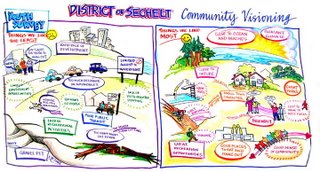
And here's the piece I put together to illustrate the major themes coming out of the meetings and interviews:
 (Sorry about the less-than-brilliant photography. I'm still learning to use my digital camera and haven't mastered the settings yet — and the lighting was too uneven to clean up in Photoshop as I did with the other two. I'm hoping to be able to rephotograph the image and touch it up properly.)
(Sorry about the less-than-brilliant photography. I'm still learning to use my digital camera and haven't mastered the settings yet — and the lighting was too uneven to clean up in Photoshop as I did with the other two. I'm hoping to be able to rephotograph the image and touch it up properly.)
All in all, it was a wonderful and intense experience, and a great learning experience for me. Keep 'em coming!
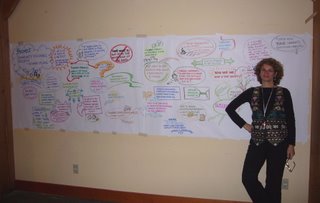 This is your faithful scribe after the final meeting, where I did live recording of feedback from the participants (as opposed to after-the-fact recording, which the others were). Live work definitely keeps you on your toes, because there isn't much time to think. The trick, I believe, is to hone your listening skills to the point where you just know what needs to be recorded and what doesn't. I'm still trying to get down everything I hear! Well, it'll all come with practice...
This is your faithful scribe after the final meeting, where I did live recording of feedback from the participants (as opposed to after-the-fact recording, which the others were). Live work definitely keeps you on your toes, because there isn't much time to think. The trick, I believe, is to hone your listening skills to the point where you just know what needs to be recorded and what doesn't. I'm still trying to get down everything I hear! Well, it'll all come with practice...
 A couple of days ago I visually recorded a session in Whistler, BC (am hoping I'll get permission to post the images here). Someone at the session told me that one of the things they loved about this process was the fact that they could see their thoughts taking concrete shape almost as soon as they uttered them. There must be something magical about seeing your words materialize into images as you speak them, because this is something I hear almost every time I do this work. It's not the same when only words get recorded. People do that at meetings all the time, and it doesn't generate the same kind of excitement.
A couple of days ago I visually recorded a session in Whistler, BC (am hoping I'll get permission to post the images here). Someone at the session told me that one of the things they loved about this process was the fact that they could see their thoughts taking concrete shape almost as soon as they uttered them. There must be something magical about seeing your words materialize into images as you speak them, because this is something I hear almost every time I do this work. It's not the same when only words get recorded. People do that at meetings all the time, and it doesn't generate the same kind of excitement.
Clearly there's some kind of alchemy that occurs when you add colour, images and symbols to the words. I'm trying to think of what it is (over and above what I said in my previous post) – and the image I come up with is baking a cake. You have your eggs, flour, butter, sugar and so on – but they don't become a cake until you put them all together in a particular way. And when you do – they combine to become something that is considerably more than the sum of their parts!
I hope that's not a totally dumb analogy. I'm hungry, so that might have something to do with it – but it makes sense to me… What do you think?
The picture above shows some of the tools of my trade.
If you're new to the idea of graphic recording, you might wonder what the point of it is. Sure, it looks pretty and colourful – but is there really anything to be gained by recording information and ideas this way, rather than just jotting notes down in bulleted lists on a good old flip chart?
Well, yes, actually, there is.

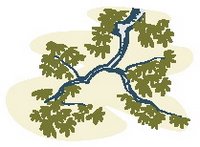 For one thing, in graphic recording, information is organized differently. Instead of the standard list format, which sets up the appearance of linear relationships between ideas, this process organizes ideas in a more organic way. Which is how ideas relate to each other in real life, if you think about it. Far from lining up one, two, three, four, they arrive in clouds…or branch out from each other…or veer off on tangents…or orbit around each other…and so on. With graphic recording, all this is depicted on the page, so you get a more accurate representation of how ideas actually relate to each other than you'd get from
For one thing, in graphic recording, information is organized differently. Instead of the standard list format, which sets up the appearance of linear relationships between ideas, this process organizes ideas in a more organic way. Which is how ideas relate to each other in real life, if you think about it. Far from lining up one, two, three, four, they arrive in clouds…or branch out from each other…or veer off on tangents…or orbit around each other…and so on. With graphic recording, all this is depicted on the page, so you get a more accurate representation of how ideas actually relate to each other than you'd get from- the usual
- bulleted
- list
- (yawn)
...and you can SEE those relationships on the page. It also seems to more closely resemble how people actually think; one person, seeing this process for the first time, said: "Your drawing looks like how the thoughts look in my head!" I thought that was pretty cool.
Then, of course, there's the old saw about one picture being worth a thousand words. Now, I happen to be just as verbal as I am visual (as anyone who knows me will attest!), but it's really true that you can often capture in a single image something that would take a couple of pages to describe in writing. And there's nothing to stop you from combining images from a graphic recording session with a "wordy" report of the proceedings, like a book with illustrations. Double your pleasure, double your fun, I say. 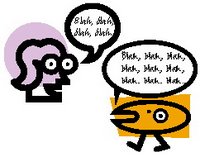
Another thing about graphic recording is that the visuals help people remember details of a meeting much better than a written report alone can do. And certainly better than those cryptic flip chart notes that are often almost unintelligible later…
And last but not least, graphic recording is dynamic, energizing and fun! Not just for the person doing it, but for everyone present. I've found that creating a real-time visual representation of people's ideas generates a level of involvement and interaction that I haven't seen in other settings, and unleashes people's own creativity and imagination. Plus it seems to loosen folks up and put them in a good mood. Because, along with everything else, graphic recording is pretty darn entertaining.
OK, disclaimer time. Not everyone twigs to this stuff. Some people just think better in words and think pictures, like Trix, are for kids. That's OK too. There is really no one method or process that works equally well for everyone. But sticking to just one way of capturing info and ideas is like living in black & white when you could have access to a full range of colour. The more senses you can engage, the richer your experience of the world - and the more likely you are to retain, enjoy, and learn from that experience.
That's how I see it, anyway. And I guess I would, eh - otherwise I wouldn't be doing this work!
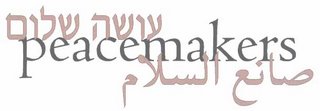 I know that in the wide world of blogdom we're supposed to post often to keep our avid readers up to date on what we're thinking and/or doing. It's hard for me to imagine that the world is waiting with bated breath for my latest pronouncements, especially since I'm not really using this blog to pronounce on anything – it's mainly meant as a public portfolio of my work in graphic recording and facilitation. So when I haven't done any new work, I haven't got anything new to post.
I know that in the wide world of blogdom we're supposed to post often to keep our avid readers up to date on what we're thinking and/or doing. It's hard for me to imagine that the world is waiting with bated breath for my latest pronouncements, especially since I'm not really using this blog to pronounce on anything – it's mainly meant as a public portfolio of my work in graphic recording and facilitation. So when I haven't done any new work, I haven't got anything new to post.
But just so you know I haven't simply been slacking off, I will let you know what else I've been up to in the past couple of weeks. As you can probably tell from the links in the sidebar, I have a big interest in dialogue. And I have a particular interest in dialogue around difficult issues, like the Israeli-Palestinian conflict. I am avid to learn about ways that we can use dialogue to achieve mutual understanding, respect and trust – and ultimately to find ways we can work together to resolve our differences. That doesn't mean we will necessarily come to see things the same way! But I believe that dialogue allows us to learn from and accept our differences, and to find the common ground on which we can build. And I believe that peace depends, among other things, on entering into dialogue with those with whom we disagree, and finding new ways to engage with – and appreciate! – each other.
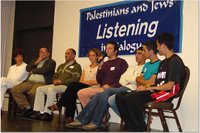
 So I was delighted to be invited to attend the Oseh Shalom~Sanea al-Salam Peacemakers Camp in California at the beginning of September. Its organizers are Len and Libby Traubman, who have been pioneers in Jewish-Palestinian dialogue and who have led the way for many others to follow. The camp ran for 3.5 days, followed by a public presentation in San Francisco the following evening. It was an electrifying and inspiring experience that would take me hours to describe here. Suffice to say that it taught me new lessons in dialogue, introduced me to many new friends, and cemented my commitment to work for peace between our two peoples. If you're interested in reading more about the camp, you can find several articles on the camp website. They've added some photos from the presentation, and you can also see the lovely graphic recording done by Nancy Margulies, whom I wrote about in an earlier post, and her equally talented daughter, Mariah Howard.
So I was delighted to be invited to attend the Oseh Shalom~Sanea al-Salam Peacemakers Camp in California at the beginning of September. Its organizers are Len and Libby Traubman, who have been pioneers in Jewish-Palestinian dialogue and who have led the way for many others to follow. The camp ran for 3.5 days, followed by a public presentation in San Francisco the following evening. It was an electrifying and inspiring experience that would take me hours to describe here. Suffice to say that it taught me new lessons in dialogue, introduced me to many new friends, and cemented my commitment to work for peace between our two peoples. If you're interested in reading more about the camp, you can find several articles on the camp website. They've added some photos from the presentation, and you can also see the lovely graphic recording done by Nancy Margulies, whom I wrote about in an earlier post, and her equally talented daughter, Mariah Howard.
So that's what I've been busy with, and it's occupied my mind a lot. But today I did another graphic gig, and as soon as I get pix I'll post the best ones. I think I'm getting a bit better each time! Oh yeah: yesterday I bought a digital camera, so I'll be able to take my own pictures instead of depending on the kindness of strangers! Now all I have to do is figure out how to use it....
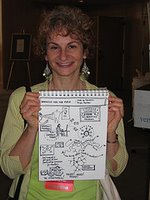 One of the first things I did when I realized I was really interested in getting into this field was to look for a workshop I could take. There seem to be a lot of things going on in California, but not much in this neck of the woods - so I was delighted to learn that there was a pro closer to home who was willing to share her knowledge. And so it was that on a lovely day in early June, I found myself in Christina Merkley's workshop at Royal Roads University, scribbling madly away on big sheets of paper and having a whale of a time. It was really exhilarating, and seeing my drawings up on the wall gave me a big boost of confidence. I thought, "I can do this stuff!"
One of the first things I did when I realized I was really interested in getting into this field was to look for a workshop I could take. There seem to be a lot of things going on in California, but not much in this neck of the woods - so I was delighted to learn that there was a pro closer to home who was willing to share her knowledge. And so it was that on a lovely day in early June, I found myself in Christina Merkley's workshop at Royal Roads University, scribbling madly away on big sheets of paper and having a whale of a time. It was really exhilarating, and seeing my drawings up on the wall gave me a big boost of confidence. I thought, "I can do this stuff!"
Christina is offering another intro workshop in October, and she's talking about a Graphic Recording Boot Camp in 2007 for those who want to take their skills to the next level. Sounds like too much fun to resist!
The photo above was taken at the NCDD conference. Yep, that's me, showing off one of the pages from my sketchbook. (You can see that page and a few others in a larger size in the post just below...)
 One of the highlights of this past month was attending the NCDD (National Coalition for Dialogue & Deliberation) conference in San Francisco. It was a brilliant conference – well-organized, exciting, thought-provoking, inspiring – chock-full of excellent workshops and presentations, amazing people, and of course, great conversation from dawn to dusk! I'd be hard pressed to pinpoint what I liked best, since I felt like a kid in a candy shop the whole time. But some highlights were: a day-long training in Compassionate Listening, a soulful and moving workshop on "Story" as an entry to sustained dialogue, and a D&D Methods Showcase featuring, among other things, a session on Graphic Capture by two of the stars in the field, Nancy Margulies and Christine Valenza.
One of the highlights of this past month was attending the NCDD (National Coalition for Dialogue & Deliberation) conference in San Francisco. It was a brilliant conference – well-organized, exciting, thought-provoking, inspiring – chock-full of excellent workshops and presentations, amazing people, and of course, great conversation from dawn to dusk! I'd be hard pressed to pinpoint what I liked best, since I felt like a kid in a candy shop the whole time. But some highlights were: a day-long training in Compassionate Listening, a soulful and moving workshop on "Story" as an entry to sustained dialogue, and a D&D Methods Showcase featuring, among other things, a session on Graphic Capture by two of the stars in the field, Nancy Margulies and Christine Valenza.
I was thrilled to meet Nancy and Christine because I've admired their work for a long time. I wondered what they would think of my efforts – so I decided to ask them. You see, instead of bringing a notebook to the conference, I decided I'd take visual notes, as though I were doing graphic recording for a meeting. So I sketched madly away whenever I could, and thought my drawings were not too bad. But would they measure up in the eyes of the masters?
I spotted Christine and Nancy in the foyer during a quiet moment and asked them if they would look at – and comment on – my sketchbook. They graciously agreed, and after their session was over I presented myself with my sketchbook and waited for their response. Much to my delight, their response was great! They were most encouraging of my efforts, and told me I was well on my way and could declare myself as a practitioner in the field without hesitation.
So without further delay, I, Avril Orloff, officially declare myself as a graphic facilitator/graphic recorder – no longer "I want to be", but "I am"! Here are a few pages from my sketchbook.
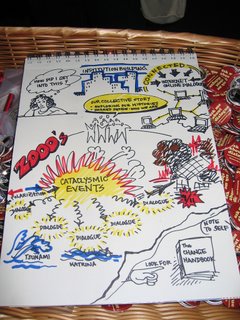
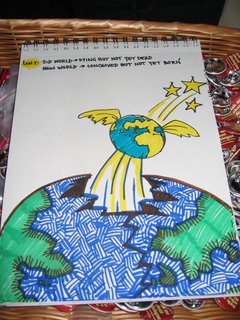
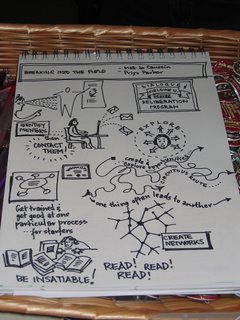
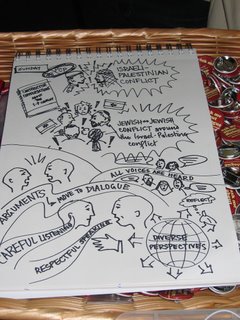
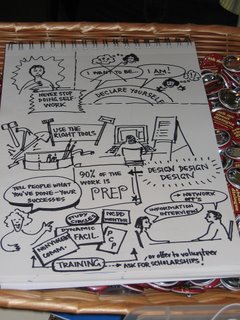
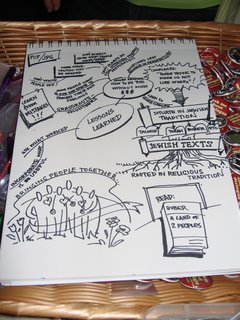
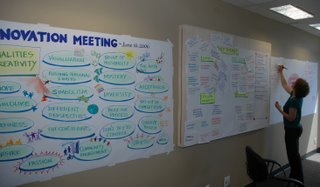
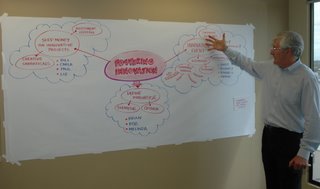 One of my favourite people to work with is John Talbot. John is one of the gurus of the community development field, and a great mentor to me and many others. I met John last January when he approached me about doing some graphic recording at a meeting he was facilitating. I didn't think I was quite ready for prime time at that point. But John encouraged me to develop my skills — and even more: he invited me to try my hand at a workshop on community development a few weeks later! This speaks volumes for John's qualities as a mentor, since neither he nor I had any idea what I'd be able to do. But he trusted that I'd produce, and apparently I did, since we've continued to team up on various projects.
One of my favourite people to work with is John Talbot. John is one of the gurus of the community development field, and a great mentor to me and many others. I met John last January when he approached me about doing some graphic recording at a meeting he was facilitating. I didn't think I was quite ready for prime time at that point. But John encouraged me to develop my skills — and even more: he invited me to try my hand at a workshop on community development a few weeks later! This speaks volumes for John's qualities as a mentor, since neither he nor I had any idea what I'd be able to do. But he trusted that I'd produce, and apparently I did, since we've continued to team up on various projects.
Unfortunately I don't have any photos of that session — but here are a couple of shots from the next meeting John and I worked together on for the Innovations Network at Community Living BC (CLBC). As is always the case when working with John, it was highly collaborative, lots of fun, and a great learning experience. Thanks, JT!
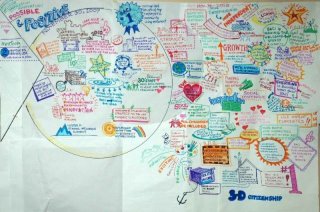 This was my first graphic job – creating a PATH for the 5-year strategic plan for BACI (Burnaby Association for Community Inclusion).
This was my first graphic job – creating a PATH for the 5-year strategic plan for BACI (Burnaby Association for Community Inclusion).
The folks at BACI decided that instead of doing a standard, linear strategic plan, they wanted something that was more 'organic' this time around. As Tanya Sather, BACI's Executive Director, explained, "We wanted something that was a lot more creative, free-flowing and inclusive, even in the way it looked. We wanted something that was beautiful to look at – something inspiring that would take us to the next level as an organization." They thought the PATH was a good fit with the organization, because they've often used it to help people with their personal planning – so why not use the same tool to plan for the organization?
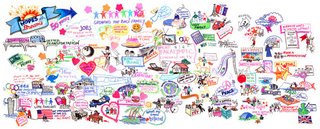 We didn't have big enough paper for the PATH, so we just taped together a whole bunch of 18x24" pages. But the good folks at BACI reproduced the whole thing onto a big canvas, which they then framed and hung in their big meeting room. They liked the process so much that they hired me to graphically record a series of "hopes & dreams" visioning sessions with their staff and the folks they serve. This is one of them.
We didn't have big enough paper for the PATH, so we just taped together a whole bunch of 18x24" pages. But the good folks at BACI reproduced the whole thing onto a big canvas, which they then framed and hung in their big meeting room. They liked the process so much that they hired me to graphically record a series of "hopes & dreams" visioning sessions with their staff and the folks they serve. This is one of them.
I had great fun doing this job for BACI and look forward to refining my PATH-making skills. This was my first taste of graphic recording, and it gave me the impetus to take things further...
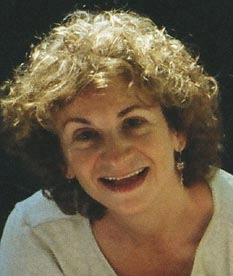 Well, [ahem], actually, I'm using this site to show off my stuff. I've recently moved into the field of graphic facilitation and wanted a place where I could post my work without the expense of creating a full website. One day when I've polished up my profile, fleshed out my portfolio and come up with wise-sounding things to say about my work, I'll put it all on a well-designed website and proudly invite you to visit it. Meanwhile, this blog gives me a nice central place to store and showcase my work, post my musings about art and communication, and feel pleasantly 'official'.
Well, [ahem], actually, I'm using this site to show off my stuff. I've recently moved into the field of graphic facilitation and wanted a place where I could post my work without the expense of creating a full website. One day when I've polished up my profile, fleshed out my portfolio and come up with wise-sounding things to say about my work, I'll put it all on a well-designed website and proudly invite you to visit it. Meanwhile, this blog gives me a nice central place to store and showcase my work, post my musings about art and communication, and feel pleasantly 'official'.
As an aside, it's amazing how being published – even self-published – instantly makes you feel like you've arrived! What do you suppose it is? The simple fact of seeing your name in print? Or is it the transition from the private and personal to the public – declaring "Here I am" and having others acknowledge that, yes, here you are indeed?
Well, whatever – here I unquestionably am. And here's some of what I've done so far in this new (to me) and fascinating pursuit...






